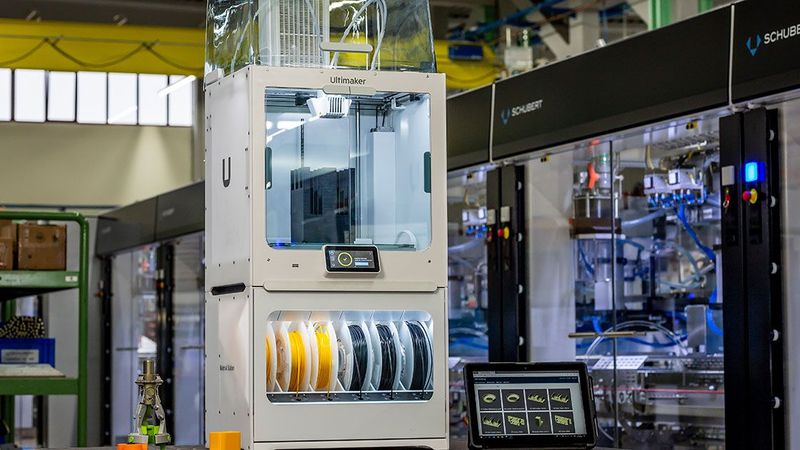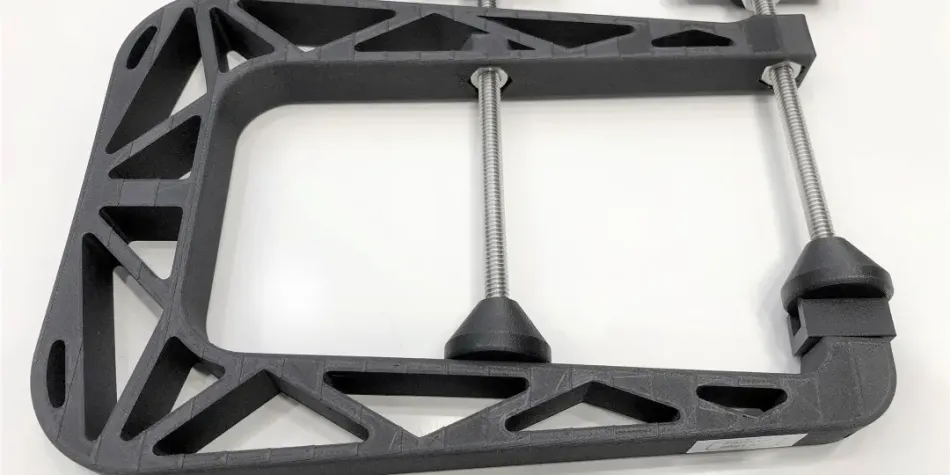Stiff and strong materials: A beginner's guide
A material’s strength refers to the maximum stress it can be put under before its failure. Its stiffness refers to how much it will deform when pulled or bent. Materials with high stiffness often also have high strength.

A material’s strength refers to the maximum stress it can be put under before its failure. Its stiffness refers to how much it will deform when pulled or bent. Materials with high stiffness often also have high strength. In the Ultimaker portfolio, this includes materials such as PLA, Tough PLA, and PC.
Why are stiffness and strength important?
Stiffness is an extremely important material quality. Knowing a material's stiffness enables you to choose from very flexible materials such as TPU and PP, and very stiff materials, such as PLA and PC. Strength, meanwhile, is important in knowing which materials should be able to bear a sufficient load for your application.

Common uses of stiff and strong materials
Stiff and strong materials – especially composites – can be used to create jigs and fixtures that can potentially replace those created via CNC out of materials such as aluminum and other “weaker” metals.
What else should you know?
Strength is measured in MPa. An MPa, or megapascal, equals one million pascals (Pa). A pascal – the standard unit used to quantify internal pressure – is one newton of force per square meter.
Stiffness is measured in GPa. A GPa, or gigapascal, equals one billion pascals.
Orientation matters. Orientation of your part is important, as fiber reinforcement of a composite material will only work on the XY (flat) plane. In the Z direction, however, the strength comes only from the polymer – not the the fibers. The Teton Smart Slicer plugin for Ultimaker Cura is a great way to help correctly orient your print. It will be available as part of Ultimaker Essentials.
“Teton's Smart Slice brings engineering-grade part simulation to Ultimaker Cura as an exclusive marketplace plugin for Ultimaker Essentials users. Using the integration options of our open and pluggable platform, it will make sure parts still meet their engineering criteria, but need less material and therefore saving valuable time and costs,” Paul Heijmans, Senior VP Software at Ultimaker, said. “The cooperation with Teton and the integration of their innovative solution are a prime example of how we will be continuously adding value for our professional customers.”
Our stiff and strong material partners
DSM
DSM Novamid 1030 CF 10 can print parts with properties close to what is achievable through injection molding – at the same speed as unreinforced plastics.
"Novamid ID1030-CF10 will allow for printing with a carbon fibre like it is an unfilled Polyamide. The addition of the carbon fibre will open up a broad range of applications. Allowing for the engineer to design for strength, design robust parts,” Danielle Glasbergen-Benning, Application Development Specialist Sports & Lifestyle at DSM Additive Manufacturing, said. "To use their structural parts in applications, at elevated temperatures in the industry of automotive, electronics to orthotics & prosthetics, as well as being able to bring additive manufacturing to the work floor in industries such as manufacturing."
LEHVOSS Group
LUVOCOM® 3F PET CF 9780 BK is the easiest carbon fiber-filled PET material to print on the market, with excellent mechanical properties, including high Z-layer strength.
LUVOCOM 3F PAHT® CF 9891 BK is a high-temperature, carbon fiber-reinforced, polyamide-based material. It provides high strength, stiffness, and minimized water uptake.

“LUVOCOM® 3F PET CF 9780 BK and LUVOCOM 3F PAHT® CF 9891 BK are customized for FFF and based on technical polymers. They come with unique easy-to-print and outstanding mechanical properties in the XYZ direction,” Thomas Collet, Director 3D Printing Materials & Marketing, Business Unit Customized Polymer Materials at LEHVOSS Group, said. “Both grades are reinforced with 15% carbon fibers for high strength and stiffness also at elevated temperatures up to 150°C for PAHT and 125°C for PET. They are designed to fulfil the requirements of end-use parts in challenging applications.”
BASF
BASF Ultrafuse 316 L is an innovative metal-polymer composite filament for the production of metal components in a stainless-steel type 316L.

"Parts printed from FFF technology are only limited to the existing and available materials,” Roger Sijlbing, Head of Sales Additive Extrusion Solutions at BASF, said. “A broad range of engineering plastics can be processed to create extraordinary designs. With Ultrafuse 316L and the possibility to realize stainless steel parts with industrial grade post processing, stiffness and strength are pushed into a new dimension.”
Jabil
Jabil PA 4035 CF is a carbon-fiber PA12 copolymer that provides greater stiffness, strength, and toughness over similar products on the market. Its high carbon-fiber loading provides superior tensile strength and modulus, while the PA12 base promotes relatively high ductility and ease-of-handling.
"Jabil Engineered Materials is focused on extending the applications for additive manufacturing by delivering innovative materials with significantly enhanced properties,” Matt Torosian, Director of Product Management at Jabil Engineered Materials, said. “PA 4035 is a carbon-reinforced copolymer that provides significantly greater stiffness, strength and toughness while still remaining easy to print."
Ensinger
Ensinger TECAFIL PA 6 GF 30 is a 30% glass fiber reinforced polyamide that offers higher strength, rigidity, creep strength, and dimensional stability compared with unreinforced polyamide 6.
“Our TECAFIL PA 6 GF 30 filament contains 30% glass fibre to provide an increased strength and rigidity,” Dilara Yüce, Sales & Project Management, IIndustrial Profiles & Tubes for Ensinger GmbH, said. “With its high fiber volume, our PA filament can reduce shrinkage and warpage of your application.”